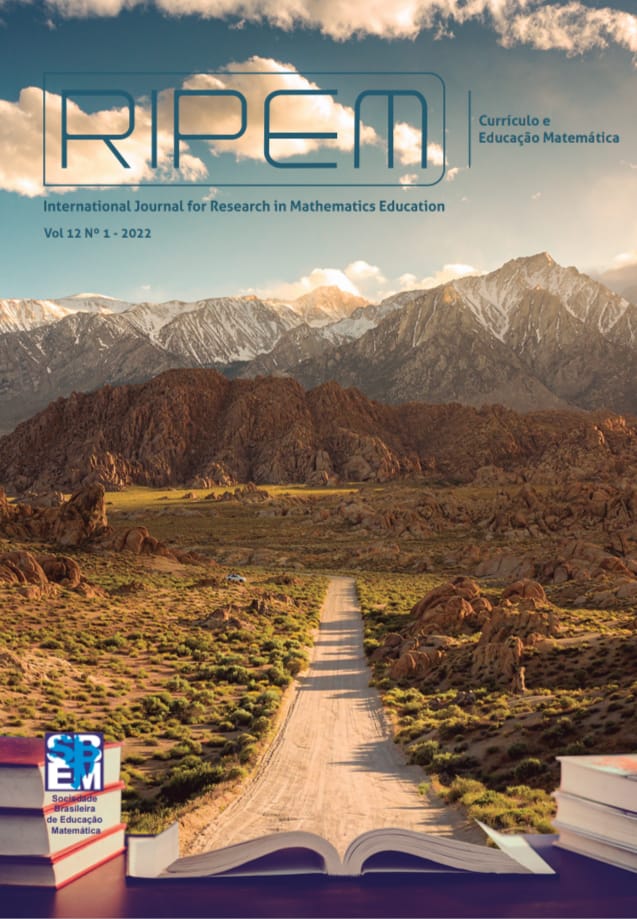Electronic didactic sequence in the consolidation of arithmetic thinking in the curriculum of the 6th year of Elementary School
DOI:
https://doi.org/10.37001/ripem.v12i1.2888Keywords:
Mathematics Education, Final Years of Elementary School, Arithmetic Thinking, Electronic Didactic Sequence, Problem SolvingAbstract
This work is an excerpt from a master's research, in which the contributions of an Electronic Didactic Sequence were investigated in the consolidation of the concepts that form Arithmetic Thinking with students from the 6th year of Elementary School. The objective is to present the Instructional Design (DI) of an Electronic Didactic Sequence, highlighting the importance of working with the Problem Solving methodology in the search for strategies that contribute to the consolidation of concepts for students who still have difficulties in understanding such concepts. The Sequences were implemented at SIENA, which is an Intelligent Teaching System, which provides students with the opportunity to perform adaptive tests and individualized recovery from difficulties, through the study of Electronic Didactic Sequences. The study is characterized by a qualitative methodology based on the case study. The results showed that the students participating in the experiment and who carried out studies of the Electronic Didactic Sequence combined with the Problem-Solving methodology obtained better individual performance, enabling the development of study autonomy, sharpening curiosity and persistence in the resolution of activities, allowing for revisiting and study the concepts at your own pace of studies.
Downloads
References
Brasil (2018). Base Nacional Comum Curricular. Educação é a base: BNCC. Ministério da Educação. Secretaria da Educação Básica. BrasÃlia, DF.
Costa, D. R. (2009). Métodos estatÃsticos em testes adaptativos informatizados. 107 f. Dissertação de Mestrado em EstatÃstica. Instituto de Matemática, Universidade Federal do Rio de Janeiro, Rio de Janeiro, Brasil.
Esteban, M. P. S. (2010). Pesquisa qualitativa em educação: Fundamentos e Tradições. Porto Alegre: Artmed.
Groenwald, C. L. O. & Sauer, L. de O. & Franke, R.F. (2005). Desenvolvendo o Pensamento Aritmético utilizando os conceitos da Teoria dos Números. Acta Scientiae, Canoas, v.7, n.1, pp.93-101, jan./jun.
Linz, R. C. & Gimenez, J. (1997). Perspectivas em Aritmética e Ãlgebra para o século XXI. São Paulo: Papirus.
Oliveira, F. S. M. de A. (2015). Crianças de 5° ano do Ensino Fundamental resolvendo problemas de divisão: a calculadora pode contribuir? Dissertação de Mestrado. Universidade Federal de Pernambuco, Pernambuco. Brasil.
Onuchic, L. de la R. & Allevato, N. S. G. (2011). Pesquisa em Resolução de problemas: caminhos, avanços e novas perspectivas. Bolema, Rio Claro, v. 25, n. 41, pp.73-98, dez.
Penalva, C. M. & Llinares, S. (2011). Tareas Matemáticas en la Educación Secundaria. In: GOÑI, Jesus MarÃa (coord) et al. Didáctica de las Matemáticas. Colección: Formación del Profesorado. Educación Secundaria. Barcelona: GRAÓ. 12, 27-51.
Perrenoud, P. (2000). Dez Novas Competências para Ensinar. Porto Alegre: Artmed.
Piaget, J. (1971). A epistemologia genética. Petrópolis: Vozes.
Polya, G. (1995). A Arte de Resolver Problemas: um novo aspecto do método matemático. Rio de Janeiro, Interciência.
Ponte, J. P. da. (1994). O estudo de caso na investigação em Educação Matemática. Quadrante, v.3, n.1, pp.3–18.
Ponte, J. P. da. (2017). Investigações Matemáticas e investigações na prática profissional. São Paulo: Livraria da FÃsica.
Schaeffer, N. (2019). Pensamento Aritmético: um experimento com estudantes do 6º ano do Ensino Fundamental. Dissertação de Mestrado. Universidade Luterana do Brasil. Canoas. Brasil.
Smith, M. S. & Stein, M. K. (1998). Selecting ans Creating Mathematical Tasks: Foram Research to Practice. Matehmatics Teaching in the Middle Scholl, 3, 344-50.
Walle, J. A. V. (2009). Matemática no Ensino Fundamental: Formação de Professores e Aplicação em Sala de Aula. Tradução: Paulo Henrique Colonese. Porto Alegre: Artmed.
Villella, J. (1998). Piedra libre para la Matemática. Buenos Aires: Copyright.
Zabala, A. (1998). A Prática educativa: como ensinar. Porto Alegre: Artmed.
Zabala, A. & Arnau, L. (2010) Como aprender e ensinar competências. Porto Alegre: Artmed.
Published
How to Cite
Issue
Section

This work is licensed under a Creative Commons Attribution-NonCommercial-NoDerivatives 4.0 International License.








